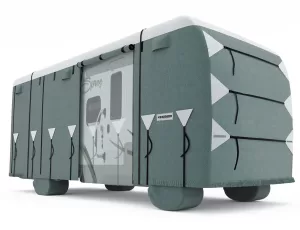The Gems Of Alachua County, Florida
Home to Gainesville and the University of Florida, this area lends itself to diving into nature, history, and culture.
By Kathleen Walls, F522187
December 2023
Alachua County, Florida, is often overlooked in favor of Orange County with Disney World and other theme parks, or bustling Miami-Dade County. Alachua County is full of small towns, state parks, natural attractions, and many other reasons to visit — including less traffic. Here’s a sampling of what to explore if you find yourself in north-central Florida.
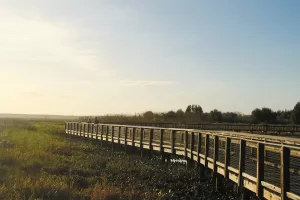
Explore 21,000-acre Paynes Prairie Preserve State Park.
MICANOPY
Micanopy calls itself “the town that time forgot.” It’s the oldest continuously inhabited inland town in Florida and is home to Paynes Prairie Preserve State Park. The park has 50 RV spots with hookups and 33 primitive camping spaces. From atop its 50-foot-tall observation tower, you can view wild horses, bison, Florida Cracker cattle, and up to 300 species of birds. The tower is accessible from one of the park’s eight trails. You’ll see deer all over the park. The visitor center functions as a museum, telling the history of the area.
You’ll want to spend at least a day in Micanopy, which is sometimes referred to as Florida’s antiques capital. Oak-tree-lined Cholokka Boulevard is filled with antique shops and unique dining spots.
To get a feel for Micanopy’s history, visit the Micanopy Historical Society Museum. It’s housed in the old Thrasher Warehouse and features a 1930s Coca-Cola mural on its north wall. The warehouse, built in 1890, was used by J.E. Thrasher Sr. as a storage facility for his general merchandise business. When his store in town burned down in 1911, he moved his retail business to the warehouse while he rebuilt the store.
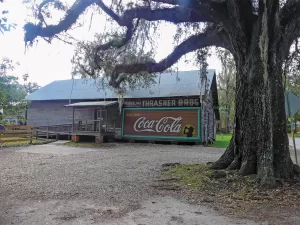
The Micanopy Historical Society Museum’s Coca-Cola mural.
Museum exhibits include the old J.E. Thrasher General Store and much more. They tell of the Seminole wars, including a display with a 6-pound cannon that was used in the Second Seminole War at Fort Micanopy. Other displays focus on movies that were filmed in Alachua County, including Doc Hollywood and parts of Cross Creek.
After visiting the museum, you can stroll along Cholokka Boulevard and see many of the actual film locations. House of Hirsch Too Antiques today occupies the 1911 Fontaine home that became the hospital in Doc Hollywood. Outpost Antiques, next to the tiny Log House antique shop, was a garage in the movie. Delectable Collectibles, housed in Micanopy’s first bank building, naturally became the film’s bank location. Wren Wood Antiques was the hotel in Cross Creek and the butcher shop in Doc Hollywood.
The Micanopy Historic Cemetery was founded in the early 1820s by Dr. H. Lucious Montgomery Sr., a local physician. He died in 1914, and he and his wife are buried there. James William Martin, 1737-1826, was the first recorded burial in the cemetery. The moss-laden oak trees and azalea bushes make it a beautiful spot to relax.
The town offers many choices for dining. We had lunch at Coffee n’ Cream, where musician David Menefee played guitar and sang. The stuffed tomato with chicken salad is delicious. Old Florida Café is another good option.
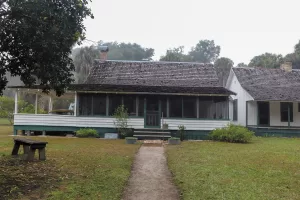
The homestead of Pulitzer Prize winner Marjorie Kinnan Rawlings is now a state park and national historic site.
CROSS CREEK
Marjorie Kinnan Rawlings Historic State Park preserves the home and farm of the Pulitzer Prize-winning author. If you visit the park Thursday through Saturday, you can tour her house. It looks much as it did when she typed her 1938 novel The Yearling and Cross Creek, published in 1942, on the old Remington typewriter that still sits on the table in the home. There’s also a pen and ink- well, an ashtray with her Lucky Strike cigarettes, and some typed pages of the Cross Creek manuscript.
The guest room includes photos of famous people who visited, including poet Robert Frost and writers Zora Neale Hurston, Ernest Hemingway, and Margaret Mitchell.
Marjorie’s bedroom looks as though it is still in use. A dress is draped across the pineapple post bed, a string of pearls hangs partially out of her jewelry box, and a suitcase sits at the foot of the bed.
The kitchen shows her love of cooking. The white porcelain wood- stove and cast-iron cookware appear ready to use. The pantry is stocked, and a corn husk floor scrubber is propped in a corner. In the dining room, the table is set with Marjorie’s authentic dishes.
The back porch invites you to step out to visit a nearby garden, which was filled with produce, herbs, and flowers during my visit.
As you walk around the garden and past the pump house, resident ducks and chickens scamper out of your way. Oranges were ripening on the trees when I visited. Take the Hammock Trail, which winds through cypress, cabbage palm, and oak trees; wooden signs along this path feature quotes from Marjorie’s books.
One side of the trail continues through the woods; the other leads to the Tenant House, a building that was moved to the property from across the highway. The Tenant House appears as it would have been when Marjorie’s help lived there, furnished with simple beds, chairs, and tables. Its two bedrooms are joined by a small pantry.
A board-and-batten barn in the park today is a re-creation of the one that stood on the premises when Marjorie arrived. The stable contains a carriage, the tools needed to tend an orange grove in the mid-20th century, and a small skiff like the one she used for trips on Cross Creek.
If you’re looking for dining options in Cross Creek, a must is The Yearling, just down the road from the park. It’s almost a small museum with delicious local food.
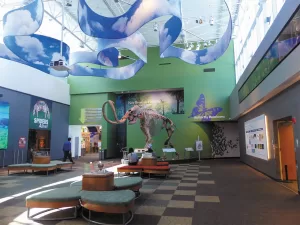
The Florida Museum of Natural History in Gainesville.
GAINESVILLE
Gainesville is the largest city in Alachua County and home to the University of Florida. Gainesville boasts an amazing number of museums and natural attractions. Many are affiliated with the college and offer free admission, among them the Florida Museum of Natural History with its amazing “Butterfly Rainforest” exhibit.
The Museum of Natural History is considered one of the nation’s top five natural history museums. It’s divided into sections that include “Florida Fossils: Evolution of Life and Land,” “South Florida People and Environments,” “Antarctic Dinosaurs,” and “Discovery Zone” for kids.
“Butterfly Rainforest,” a paid exhibit attached to the museum, features approximately 1,000 free-flying butterflies and birds from around the world in an outdoor enclosure filled with tropical plants, waterfalls, and a walking trail. Besides the flying creatures, you’ll also see turtles and fish. When I first entered the exhibit, the beautifully colored butterflies fluttered around, and some landed on my arm. One small bird stepped around amid the bushes. His soft gray- and rust-colored feathers blended into the shadows of the leaves. My favorite butterflies, blue morphos, sport vivid blue wings fringed with black and dots of red on their upper body; the underside of the wings is mostly brown, with eye-shaped markings.
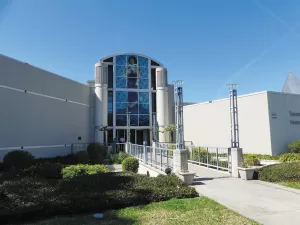
Open since 1990, the Harn Museum of Art has served over 2.5 million visitors.
Another free University of Florida museum is the Harn Museum of Art. My favorite exhibit there is “Florida Impressions,” which offers a look at old Florida through 50 or so paintings, from historic landmarks to coastlines and waterways. These works were painted in the early to mid-20th century by famous artists who visited Florida.
The university is also home to about 500,000 bats in the UF Bat Houses. Every evening, just after sunset, the bats emerge and consume up to 2.5 billion insects during their nightly hunt. Watching this free show on the shore of Lake Alice is a nightly event; when I was there, dozens of spectators were on hand as the bats emerged. Free parking is available.
Other attractions in Gainesville include the Matherson History Museum. Admission is free at this small museum, although donations are accepted. The main hall features a current exhibit titled “Return to Forever: Gainesville’s Great Southern Music Hall.” Between 1974 and 1978, Gainesville’s top concert venue, Great Southern Music Hall, located in the historic Florida Theatre, hosted greats such as Muddy Waters, Jimmy Buffett, Bob Seger, Ray Charles, Steve Martin, Ike and Tina Turner, the Count Basie Orchestra, Alachua County’s own Bo Diddley, and many more. This exhibit runs through April 2024, according to museum staff.
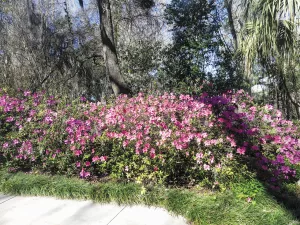
Kanapaha Botanical Gardens is home to many species of flowers, including azaleas.
On the natural side, Kanapaha Botanical Gardens showcases Florida’s native flora. The facility boasts the largest herb garden in the Southeast and Florida’s largest public bamboo display. Stroll along the paved walkway and step off to explore the many small nooks. One pond has koi you can feed. I loved the many sculptures and the colorful children’s playground.
Devil’s Millhopper Geological State Park is a miniature rainforest at the bottom of a 120-foot-deep, bowl-shaped sinkhole. A pavilion with placards offers insights into its history. Arrowheads found in the sinkhole prove that people have visited the area since ancient times. Early visitors who saw bones and fossils at the bottom of the sinkhole believed these creatures had gone there to meet the devil. Actually, the sinkhole formed when the limestone underneath it collapsed. The walk to the stairway that leads down to the sinkhole is short. You can view the sinkhole from the top or venture down to it.
Carson Springs Wildlife Conservation Foundation is a conservation and education facility that rescues exotic animals in need. It’s home to approximately 30 rare and endangered species and over 100 animals. The owners, Christine and Barry Jenks, take in rescued, abused, or unwanted big cats and other animals. The animals receive a permanent home and lots of love there. I took a two-hour walking tour where I got up close with the animals. I met Tank, their largest Bengal tiger, who was showing off his boxing skills with a large plastic barrel hanging in his spacious enclosure. He was happy with the chicken treats that our guide, Anna, and owner Barry offered. He’s their youngest tiger, but also the biggest one there, at about 8 feet long. He shares a large enclosure with Tabitha, a rare golden tabby.
That was just the start. Anna introduced us to many other animals: more tigers, plus warthogs and otters. You can take the walking tour, opt for a riding one, or arrange for a private tour.
Visit Bo Diddley Community Plaza downtown and see the famous Florida Theatre across the street. A number of great restaurants are located around the plaza. My go-to choice is Harry’s Seafood Bar & Grille, housed in Gainesville’s historic Opera House. For pizza, you can’t beat Satchel’s Pizza for both the food and the fun atmosphere, including an old hippie van.
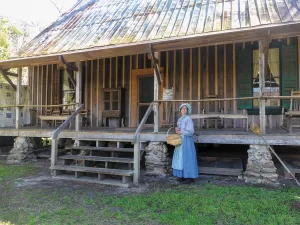
The authentic working farm at Dudley Farm Historic State Park covers 325 of the original 640 acres.
NEWBERRY
Newberry, just outside Gainesville, is home to Dudley Farm Historic State Park, which showcases the evolution of one family’s Florida farm. The authentic 325-acre working “Cracker” farm recalls the pioneer days of the 1850s when Phillip B.H. Dudley and his wife, Mary, purchased the land. The property was further developed, including building the current farmhouse, by son Ben and his wife, Fannie. It eventually was passed to Miss Myrtle Dudley, the youngest of their 12 children and the last remaining Dudley on the farm until her death in January 1996 at 94 years old. She donated 24 acres to the park service in 1983. The park service later added 232 acres.
The visitor center is a museum with family artifacts. When I visited, two musicians dressed in period clothing were playing a banjo and a fiddle on the center porch. The front section contains several historic buildings, including the commissary and gift shop, a blacksmith shop, and lots of antique farm equipment.
The actual Dudley Farm still includes the home of Ben Dudley, originally built in 1880. Guests can walk through the house, sit in a rocker on the porch, pump water from the well, and visit the free-range turkeys and chickens. The kitchen is behind the house. Don’t miss the Florida Cracker horses and cattle grazing in the back of the farm.
Alachua County is less than 40 miles wide and Gainesville is near the center, so it’s easy driving, with fewer than 15 miles between these places. Consider exploring the wealth of attractions in this part of the Sunshine State.
MORE INFO
Alachua County Visitors & Convention Bureau
visitgainesville.com
(352) 374-5260
(866) 778-5002
HOW DO YOU SAY IT?
The name Alachua is derived from the language of the area’s earliest known settlers, the Timucuan Indians. Today, its pronunciation depends on what you’re referring to: the county (“ah-LATCH-you-uh”) or the city (“ah-LATCH-you-way”).
The post The Gems Of Alachua County, Florida appeared first on Family RVing Magazine.
Source: https://familyrvingmag.com/2023/12/01/the-gems-of-alachua-county-florida/


